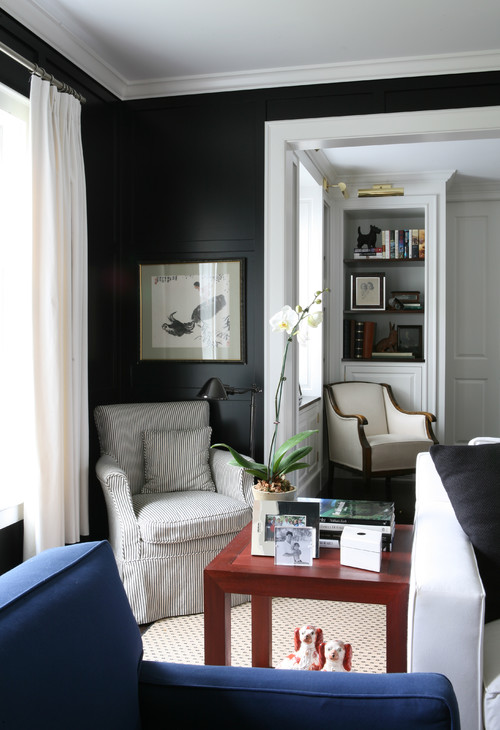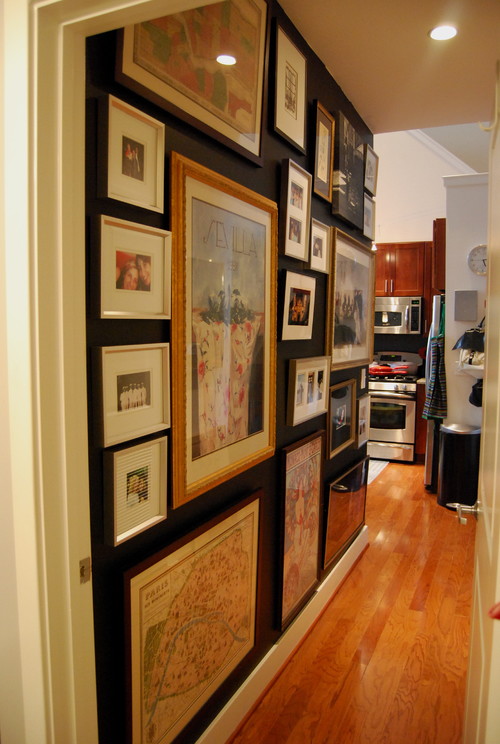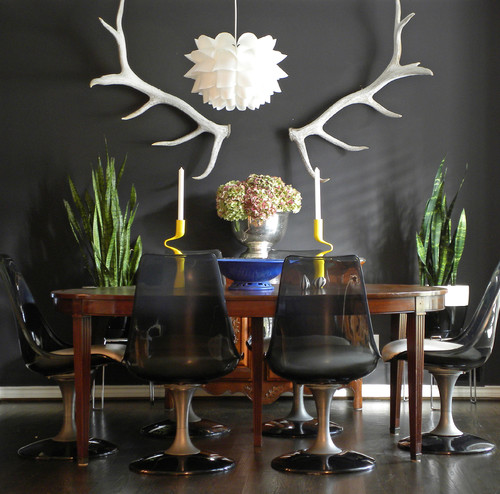Let's pretend that you've just stepped into a paint store, armed with swatches, your head bursting with the names and numbers of black colors, and the Trivia Gremlin pops up and says, "Don't be silly! Black isn't a color!"
Seriously?
"Look it up on Wiki," Gremlin says.
You mean, I've been calling it the wrong thing for decades?
Maybe I should be more careful. Maybe the next time I walk into a furniture store, I should say, "I'd like to see a chair that's, um, how to describe it? A chair that isn't a color.
Is black the absence of color? A mix of all colors?
For our purposes, we'll refer to it as a color, and the gremlin can go eat cake. Well, it's a good thing that gremlins don't exist (more cake for us, right?), because black is one of the most alluring, sophisticated colors in a paint deck.
Historically, black is the shade of mourning. It symbolizes submission and was favored by religious orders. The color didn't achieve fashion status until the 15th century--then, it lost favor when it became associated with bad luck and black cats.
Now, it's associated with the little black dress and black tie events.
Black is used as a grounding element by interior designers--
or an entire background.
Now, it's associated with the little black dress and black tie events.
Black is used as a grounding element by interior designers--
or an entire background.
You might be reluctant to paint a room black--this reluctance might have hardened into dislike if you've ever had to paint a dark room a lighter color. Then, some people are flat-out scared. We've been told that a black outfit will make us seem thinner, so common wisdom says that it will turn any room into an itty bitty space.
Forget all you know about black.
This color can instantly make a small space look larger. It can add glamour, bling, drama--and depth. Many years ago I had two black rooms--one with windows, one with poor lighting. I did not choose them. I was too chicken. I was led down this path by an interior designer, and in my mind, I thanked her every day.
Those rooms were gorgeous.
In my present home, I didn't use a designer, and I felt very bold when I opted for greige in the powder room.
A word about powder rooms. They're special, little places. Guests tend to linger in our living and dining areas,
but they spend minutes in a powder room.
These spaces are often described as "little jewel boxes," the perfect spot for homeowners to be wild or grand, as elegant as elegant can be, a place for your guests to open a small gift box and know that you created it just for them.
Many powder rooms are tiny and windowless, and designers often choose whites or sunny colors to give a feeling of space and light.
Others use dramatic reds, which are lovely and memorable, but like many jewel-tones, red is assertive, and it isn't neutral (more later).
Just how far will you take powder room drama?
Black was the first color I thought of when I saw my small, windowless powder room. "This is the place to strike out boldly,"
I told myself. But how bold?
but they spend minutes in a powder room.
These spaces are often described as "little jewel boxes," the perfect spot for homeowners to be wild or grand, as elegant as elegant can be, a place for your guests to open a small gift box and know that you created it just for them.
Many powder rooms are tiny and windowless, and designers often choose whites or sunny colors to give a feeling of space and light.
Others use dramatic reds, which are lovely and memorable, but like many jewel-tones, red is assertive, and it isn't neutral (more later).
Just how far will you take powder room drama?
Black was the first color I thought of when I saw my small, windowless powder room. "This is the place to strike out boldly,"
I told myself. But how bold?
Using black paint in a small, dark room seems counter intuitive, but the color is a chameleon--and, as previously mentioned,
it can create drama and high style.
The unspoken rule is: Small spaces can handle big design.
But if you use black, you must be very, very brave.
I have other options. I could use tile, but it's costly and (IMO) permanent. I really want to keep the wooden floor and the pedestal sink. But, as much as I love beige,
the color isn't doing one positive thing.
The room doesn't look bigger.
It's the opposite of a jewel box, more like a "time-out" box where bad decorators go after they make mistakes.
I searched for examples of black rooms on Houzz, and found quite a few. Here, the walls have been trimmed.
An art gallery breaks up this black wall, which acts as a neutral canvas for the colorful prints.
By the way, the color is Benjamin Moore Black 2132-10
One thing I learned from a black room: it acts as a neutral and turns lighter objects into pieces of art.
Above, the walls have been painted "Caviar," by Sherwin-Williams
Paired with white, black is very lovely.
I love all-white bathrooms, but paint won't fix my room. I'd need wallpaper or tile--and I am not ready for that kind
of financial commitment.
of financial commitment.
Beadboard isn't inexpensive, but it would last forever--
and it can be repainted. A flat finish would be elegant (but scary in a bathroom), and high gloss would bounce light; a satin finish would add a subtle polish and would be impenetrable to water.
Naturally I vote for a lacquer like finish because it would make the jewel box dazzle.
I'm imagining a black beadboard powder room with a white pedestal sink and an over-the-top white mirror.
"Caviar" by Sherwin Williams
I'm imagining abundant lighting, gorgeous sconces, and the judicious use of mirrors. I'm imagining a white orchid on a white painted table, nickel faucets, white guest towels, colorful art on the walls. I can't go wrong by painting a wall, right?
Before you go, I have a few questions:
1. Would you paint a room black?
2. Have you done it? What were the results?
3. What color would you paint this room?
4. Would you opt for tile? Beadboard? Something else?
Stay tuned for another episode of Renovation Diary, when MLee and her wild ideas will doubtlessly end up in the "time-out" box.
See you later with chocolate-dipped strawberries, a divine treat for all foodies and DIY designers.
XOXO
I'm imagining abundant lighting, gorgeous sconces, and the judicious use of mirrors. I'm imagining a white orchid on a white painted table, nickel faucets, white guest towels, colorful art on the walls. I can't go wrong by painting a wall, right?
Before you go, I have a few questions:
1. Would you paint a room black?
2. Have you done it? What were the results?
3. What color would you paint this room?
4. Would you opt for tile? Beadboard? Something else?
See you later with chocolate-dipped strawberries, a divine treat for all foodies and DIY designers.
XOXO
Social Bookmarking






















No comments:
Post a Comment